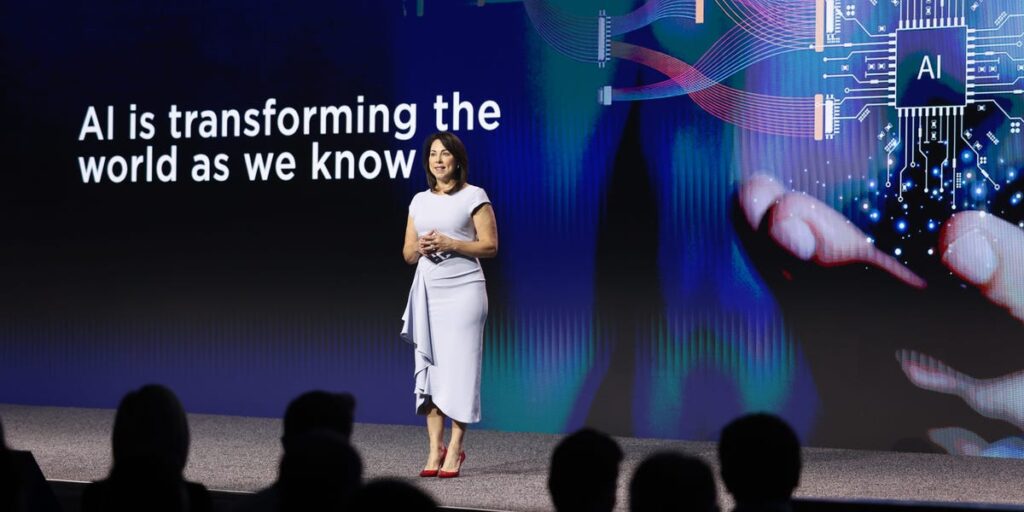- AI is here to stay. So where does it fit into your company?
- Tech execs discussed AI’s role in the workplace at the trade show MWC Las Vegas.
- This article is part of “5G and Connectivity Playbook,” a series exploring one of our time’s most important tech innovations.
The pressure is on for many companies to figure out how best to implement AI — and guardrails around its use — in their workplaces.
At the mobile communications trade show Mobile World Congress Las Vegas last week, tech execs from companies like Salesforce, Verizon, and Qualcomm shared their thoughts on AI’s role in the future workforce, and what business leaders should do about AI now.
“We’ve reached a point where, for enterprises, generative AI is not a luxury, not an option to be considered, but it’s a necessity,” said Durga Malladi, senior vice president and general manager of technology planning and edge solutions at Qualcomm.
As far as where AI fits in among human employees at work, the general view is that AI “should complement, not replace humans,” said Shankar Arumugavelu, executive vice president and president of Verizon Global Services.
Arumugavelu laid out some of Verizon’s applications for AI, including network operations management, workforce planning, and customer service. He also touted a need for oversight of AI at work, pointing to the creation of Verizon’s AI Council, a leadership group overseeing the company’s approach to AI adoption, development, and deployment.
“With generative AI at Verizon, last year was all about aggressive experimentation,” he said. “This year is about thoughtful implementation at scale. The focus is on accelerating AI responsibly, including making sure we have the right oversight in place to mitigate the risks while exploring ways the technology can help us better serve our customers, employees, and communities.”
While the continue to be concerns about potential bias in AI, the tech may be positioned to point out, not enact, bias in some cases, said Paula Goldman, Salesforce’s first-ever chief ethical and humane use officer.
Goldman said a VC firm that her friend works at uses AI on their mobile devices in their investment decision-making, where it listens, takes notes, and finds patterns. The firm’s AI also pointed out possible bias.
“Sometimes, the people in the room haven’t caught that pattern, or sometimes, in fact, they do — but they find it difficult in the moment to raise the issue,” she said. “But AI is not afraid to raise the issue, and as a result, they have a much, much richer conversation and they have better decision-making.”
Speakers at MWC Las Vegas also struck a cautionary chord on AI, citing issues with AI, like hallucinations, and emphasizing the need for responsible adoption and development of the tech.
“The use cases of today that I’m seeing deployed across a wide variety of telcos and regulated industries, in general, are probably more internal-facing where you don’t have as big of a risk if there’s a hallucination or something goes wrong,” said Julian Williams, an industry lead of retail and telecommunications at Anthropic.
“And where I’m seeing a little bit more hesitation and where people really need to invest in their red-teaming efforts, really need to invest in their evaluation frameworks, is those large external-facing use cases that are actually going to touch millions of customers,” Williams added.
Others cautioned about companies getting swept up in the AI boom and implementing AI just for the sake of it.
“One of the things that we’ve seen with gen AI is that people have jumped from technology and then trying to find a use case for it,” said Piers Sanders, chief product officer at AI solutions company Sand Technologies. He talked about the importance instead of staying grounded in the need to “really understand customer problems” and focus on the product accordingly.
In her keynote, Salesforce’s Goldman concluded with the importance of “making sure that we’re leveraging AI in service of human strengths.”
“To make AI work for our businesses, we have to first make sure it works for the people our businesses serve and the people our businesses employ,” she said. “And when we do that, when we truly use AI in service of people, we are able to unlock this incredible future in which we get the best of AI and the best of human intelligence together.”
Read the full article here
















